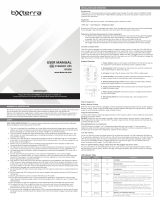
2
1.2 Radio Frequency Interference
This equipment has been tested and found to comply with the limits for a Class B digital device, pursuant to
Part 15 of the FCC Rules and the Class B limits for radio noise emissions from digital apparatus set out in
the Radio Interference Regulations of the Canadian Department of Communications. These limits are de-
signed to provide reasonable protection against harmful interference in a residential installation. This
equipment generates, uses and can radiate radio frequency energy and, if not installed and used in accor-
dance with the instructions, may cause harmful interference to radio communications.
However, there is no guarantee that interference will not occur in a particular installation. If this equipment
causes interference to radio or television reception, which can be determined by turning the equipment off
and on, the user is encouraged to try to correct the interference by one or more of the following measures:
n reorient the receiving antenna
n increase the separation between the equipment and the receiver
n connect the equipment to an outlet on a circuit different from that to which the receiver is connected
n consult the dealer or an experienced radio/TV technician for help.
Shielded communications interface cables must be used with this product.
WW
WW
W
arar
arar
ar
ning:ning:
ning:ning:
ning: Changes or modifications to this unit not expressly approved by the party responsible for compli-
ance could void the user’s authority to operate the equipment.
1.3 Theory of Operation
This high-performance, line-interactive, uninterruptible power source (UPS) provides clean, reliable, AC
power to computer systems — protecting them from power blackouts, brownouts, swells, sags, surges, and
interference.
Normally, the UPS operates “on-line,” supplying power from the
utility inpututility input
utility inpututility input
utility input to the
loadload
loadload
load (workstation,
server, or other device). The
concon
concon
con
vv
vv
v
erer
erer
er
terter
terter
ter circuitry is used to maintain an optimal float charge level on the
baba
baba
ba
t-t-
t-t-
t-
terter
terter
ter
yy
yy
y.
When the utility fails, the
disconnect disconnect
disconnect disconnect
disconnect switch opens and the
con con
con con
con
vv
vv
v
erer
erer
er
terter
terter
ter supplies AC power to the
loadload
loadload
load. The
loads operate normally until shut down or until the battery is exhausted. The UPS automatically transfers
the load back to utility power and recharges the batteries when the line voltage returns to normal.
The UPS also provides surge protection and
EMI/RFI fEMI/RFI f
EMI/RFI fEMI/RFI f
EMI/RFI f
ilteringiltering
ilteringiltering
iltering, as well as
SmarSmar
SmarSmar
Smar
tBoost™ tBoost™
tBoost™ tBoost™
tBoost™ and
SmarSmar
SmarSmar
Smar
tTtT
tTtT
tT
rim™rim™
rim™rim™
rim™
automatic voltage regulation, which corrects high and low input voltage without drawing power from the
battery.
Output contrOutput contr
Output contrOutput contr
Output contr
olol
olol
ol uses the UPS’s remote interface to turn the load on or off, without disabling other UPS
functions.




















